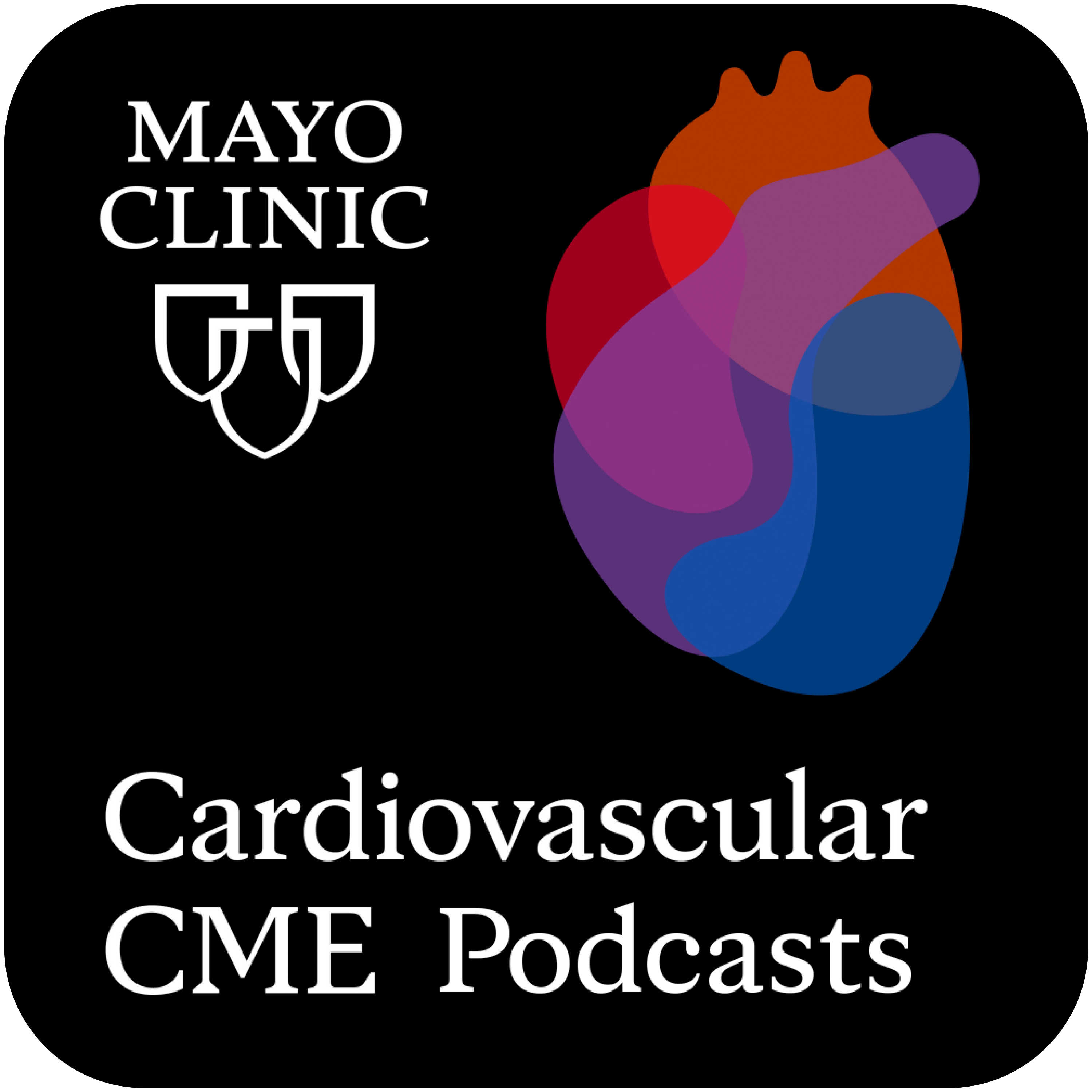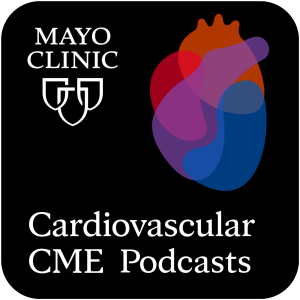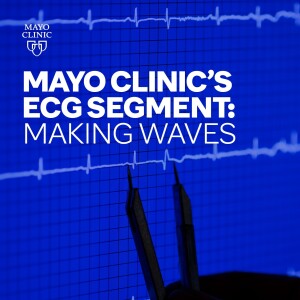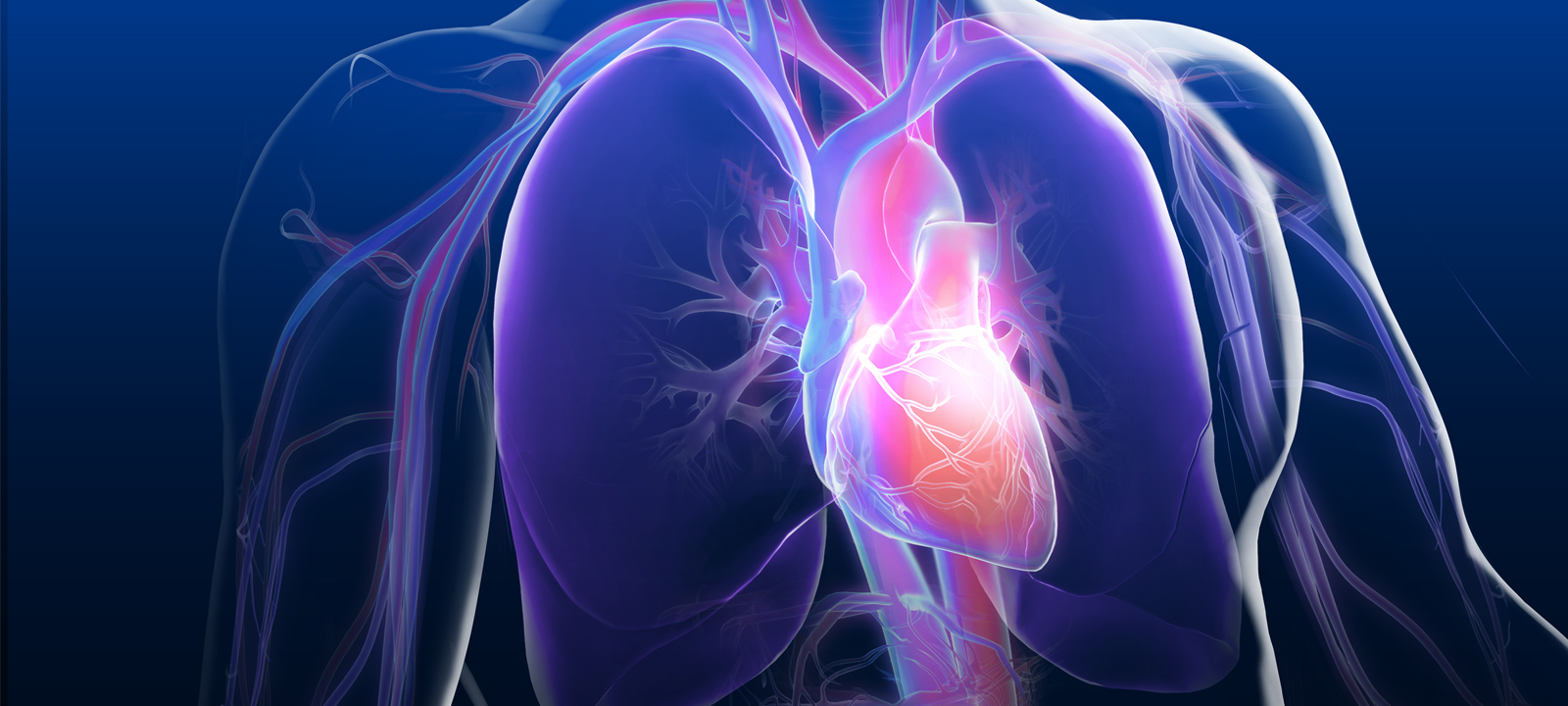
380.1K
Downloads
262
Episodes
The Cardiovascular CME podcast is a free educational offering from Mayo Clinic, featuring content geared towards physicians, physician assistants, and nurse practitioners who are interested in exploring a multitude of cardiology-related topics. Tune in and subscribe to explore today’s most pressing cardiology topics with your colleagues at Mayo Clinic and gain valuable insights that can be directly applied to your practice. No CME credit offered for podcast episodes at this time.
Episodes

Tuesday Nov 22, 2022
Carcinoid Heart Disease
Tuesday Nov 22, 2022
Tuesday Nov 22, 2022
Carcinoid Heart Disease
Guest: S. Allen Luis, M.B.B.S., Ph.D.
Host: Malcolm R. Bell, M.D.
Joining us today to discuss carcinoid heart disease is Malcolm Bell, M.D., a professor of medicine and interventional cardiology expert and S. Allen Luis, M.B.B.S., Ph.D., an associate professor of medicine and cardiovascular ultrasound expert at Mayo Clinic in Rochester, Minnesota. Dr. Luis specializes in the treatment of the uncommon condition, carcinoid heart disease. Tune in to learn more about the rare condition.
Specific topics discussed:
- What is carcinoid heart disease?
- What valves are most affected and what are the indications to intervene for valvular disease related to carcinoid syndrome?
- Periprocedural carcinoid crises are associated with procedural adverse outcomes and mortality. What should be done is the periprocedural setting to minimize this risk?
Connect with Mayo Clinic's Cardiovascular Continuing Medical Education online at https://cveducation.mayo.edu or on Twitter @MayoClinicCV.
NEW Cardiovascular Education App:
The Mayo Clinic Cardiovascular CME App is an innovative educational platform that features cardiology-focused continuing medical education wherever and whenever you need it. Use this app to access other free content and browse upcoming courses. Download it for free in Apple or Google stores today!
No CME credit offered for this episode.
Podcast episode transcript found here.

Thursday Nov 10, 2022
Thursday Nov 10, 2022
Personalized Computational Heart Models to Predict Sudden Death Risk in Hypertrophic Cardiomyopathy
Guest: Ryan O'Hara, Ph.D.
Hosts: Anthony H. Kashou, M.D. (@anthonykashoumd)
Joining us today to discuss Personalized Computational Heart Models to Predict Sudden Death Risk in Hypertrophic Cardiomyopathy is Ryan O'Hara, Ph.D., candidate in biomedical engineer at Johns Hopkins University in Baltimore Maryland. His current research focuses on the electrophysiology of both ischemic and non-ischemic cardiomyopathies.
In this episode, we will look at hypertrophic cardiomyopathy in further detail, as well as how personalized computational heart models can be used to improve risk stratification of these patients.
Specific topics discussed:
- What is hypertrophic cardiomyopathy (HCM) and how does it affect the heart? What are the risks?
- How is sudden cardiac death risk clinically stratified in patients with HCM? What is the typical treatment?
- What is a computational, or virtual, heart and how can it be used clinically?
- What benefit do virtual hearts reconstructed with T1 imaging add to improve patient risk stratification in HCM?
Connect with Mayo Clinic's Cardiovascular Continuing Medical Education online at https://cveducation.mayo.edu or on Twitter @MayoClinicCV and @MayoCVservices.
Facebook: MayoCVservices
LinkedIn: Mayo Clinic Cardiovascular Services
NEW Cardiovascular Education App:
The Mayo Clinic Cardiovascular CME App is an innovative educational platform that features cardiology-focused continuing medical education wherever and whenever you need it. Use this app to access other free content and browse upcoming courses. Download it for free in Apple or Google stores today!
No CME credit offered for this episode.
Podcast episode transcript found here.

Tuesday Nov 01, 2022
Imaging for Prosthetic Valves
Tuesday Nov 01, 2022
Tuesday Nov 01, 2022
Imaging for Prosthetic Valves
Guest: Sorin V. Pislaru, M.D., Ph.D.
Host: Paul A. Friedman, M.D. (@drpaulfriedman)
Joining us today to discuss tricuspid regurgitation is Paul Friedman, M.D., a professor of medicine and chair of the department of cardiology and Sorin Pislaru, M.D., Ph.D., a professor of medicine and chair of the division of structural heart disease at Mayo Clinic in Rochester, Minnesota. Tune in to learn more about the complications of prosthetic valves in imaging.
Specific topics discussed:
- We had valvular prostheses for a long time. Surely our assessment by now is precise
- We have professional society guidelines for assessment of prosthetic heart valves. Are these valuable?
- I know we recently looked at the performance of existing diagnostic algorithms for prosthetic dysfunction. Can you share some of the highlights?
- What about multimodality imaging?
Connect with Mayo Clinic's Cardiovascular Continuing Medical Education online at https://cveducation.mayo.edu or on Twitter @MayoClinicCV.
NEW Cardiovascular Education App:
The Mayo Clinic Cardiovascular CME App is an innovative educational platform that features cardiology-focused continuing medical education wherever and whenever you need it. Use this app to access other free content and browse upcoming courses. Download it for free in Apple or Google stores today!
No CME credit offered for this episode.
Podcast episode transcript found here.

Thursday Oct 27, 2022
Artificial Intelligence in Automated ECG Analysis
Thursday Oct 27, 2022
Thursday Oct 27, 2022
Artificial Intelligence in Automated ECG Analysis
Guest: Peter Macfarlane, Ph.D., D.Sc.
Hosts: Anthony H. Kashou, M.D. (@anthonykashoumd)
Joining us today to discuss artificial intelligence in automated ECG analysis is Peter Macfarlane, Ph.D., D.Sc. He is a University of Glasgow emeritus professor and honorary senior research fellow who in 2014 was awarded Commander of the British Empire for his services to health care. Tune in to hear what the role of computer interpretation looks like today and where do artificial intelligence-based models fit in with the future of the field.
Specific topics discussed:
- Can you share a little bit about your background and how you got into computerized electrocardiography?
- How do you see the role of computerized ECG in clinical practice today, and has that evolved over the years?
- What are your thoughts on this growing field applying artificial intelligence to the electrocardiogram? Where do you see the potential benefits and limitations with this technology? And will this technology eventually become commonplace and adopted into medical practice?
Connect with Mayo Clinic's Cardiovascular Continuing Medical Education online at https://cveducation.mayo.edu or on Twitter @MayoClinicCV and @MayoCVservices.
Facebook: MayoCVservices
LinkedIn: Mayo Clinic Cardiovascular Services
NEW Cardiovascular Education App:
The Mayo Clinic Cardiovascular CME App is an innovative educational platform that features cardiology-focused continuing medical education wherever and whenever you need it. Use this app to access other free content and browse upcoming courses. Download it for free in Apple or Google stores today!
No CME credit offered for this episode.
Podcast episode transcript found here.

Tuesday Oct 25, 2022
Hybrid Ablation for Atrial Fibrillation
Tuesday Oct 25, 2022
Tuesday Oct 25, 2022
Hybrid Ablation for Atrial Fibrillation
Guest: Ammar M. Killu, M.B.B.S. (@akillumd) and Arman Arghami, M.D., M.P.H. (@Arghami)
Host: Paul A. Friedman, M.D. (@drpaulfriedman)
Joining us today to discuss hybrid ablation for atrial fibrillation is Ammar Killu, M.B.B.S., associate professor of medicine in the division of hearth rhythm services in cardiology, and Arman Arghami, M.D., M.P.H., assistant professor of surgery in cardiology at Mayo Clinic in Rochester, Minnesota. Tune in to learn more about a new way to treat recurrent atrial fibrillation.
Specific topics discussed:
- What does the Hybrid Procedure entail?
- The Pros and Cons of Hybrid Ablation.
- Why have it done at Mayo?
- Who is / is not a good candidate for this procedure?
Connect with Mayo Clinic's Cardiovascular Continuing Medical Education online at https://cveducation.mayo.edu or on Twitter @MayoClinicCV.
NEW Cardiovascular Education App:
The Mayo Clinic Cardiovascular CME App is an innovative educational platform that features cardiology-focused continuing medical education wherever and whenever you need it. Use this app to access other free content and browse upcoming courses. Download it for free in Apple or Google stores today!
No CME credit offered for this episode.
Podcast episode transcript found here.

Tuesday Oct 18, 2022
Tricuspid Regurgitation: What Will it Take to Improve Care?
Tuesday Oct 18, 2022
Tuesday Oct 18, 2022
Tricuspid Regurgitation: What Will it Take to Improve Care?
Guest: Sorin V. Pislaru, M.D., Ph.D.
Host: Paul A. Friedman, M.D. (@drpaulfriedman)
Joining us today to discuss tricuspid regurgitation is Paul Friedman, M.D., a professor of medicine and chair of the department of cardiology and Sorin Pislaru, M.D., a professor of medicine and chair of the division of structural heart disease at Mayo Clinic in Rochester, Minnesota. Tune in to learn why people get tricuspid regurgitation and how they present.
Specific topics discussed:
- Why do you think care for TR needs to be improved?
- Medical care delivery is a complex process. Where do you start changing the current pattern?
- TR is very common, and in the vast majority of patients it is secondary to other conditions. Can we apply the TRIO risk score to all patients or is this too simplistic?
- If we refer patients earlier are there better medical / interventional options
Connect with Mayo Clinic's Cardiovascular Continuing Medical Education online at https://cveducation.mayo.edu or on Twitter @MayoClinicCV.
NEW Cardiovascular Education App:
The Mayo Clinic Cardiovascular CME App is an innovative educational platform that features cardiology-focused continuing medical education wherever and whenever you need it. Use this app to access other free content and browse upcoming courses. Download it for free in Apple or Google stores today!
No CME credit offered for this episode.
Podcast episode transcript found here.

Thursday Oct 13, 2022
Device Agnostic Artificial Intelligence-based Analysis of Ambulatory ECG Recordings
Thursday Oct 13, 2022
Thursday Oct 13, 2022
Device Agnostic Artificial Intelligence-based Analysis of Ambulatory ECG Recordings
Guest: Alan Kennedy, Ph.D.
Hosts: Anthony H. Kashou, M.D. (@anthonykashoumd)
Joining us today to discuss Device Agnostic Artificial Intelligence-based Analysis of Ambulatory ECG Recordings is Alan Kennedy, Ph.D., biomedical engineer by training, and holds a Ph.D. in the application of deep learning for the diagnosis of medical conditions from Ulster University. His current work focuses on developing wearable ECG patch technology and deep learning algorithms for ECG classification.
Specific topics discussed:
- What is meant by device agnostic ECG interpretation
- How can AI enable device agnostic ECG interpretation over traditional ECG interpretation software
- How will the use of AI-ECG interpretation affect the future of Cardiology
Connect with Mayo Clinic's Cardiovascular Continuing Medical Education online at https://cveducation.mayo.edu or on Twitter @MayoClinicCV and @MayoCVservices.
Facebook: MayoCVservices
LinkedIn: Mayo Clinic Cardiovascular Services
NEW Cardiovascular Education App:
The Mayo Clinic Cardiovascular CME App is an innovative educational platform that features cardiology-focused continuing medical education wherever and whenever you need it. Use this app to access other free content and browse upcoming courses. Download it for free in Apple or Google stores today!
No CME credit offered for this episode.
Podcast episode transcript found here.

Tuesday Oct 11, 2022
Echo Guidance for MitraClip
Tuesday Oct 11, 2022
Tuesday Oct 11, 2022
Echo Guidance for MitraClip
Guest: Jeremy J. Thaden, M.D. (@JeremyThaden)
Host: Kyle W. Klarich, M.D. (@KyleWKlarich)
Joining us today to discuss echo guidance for the MitraClip is Dr. Jeremy Thaden, M.D., Associate Professor of Medicine and cardiovascular ultrasound expert at Mayo Clinic in Rochester Minnesota.
Specific topics discussed:
- What are the key parameters for patient selection prior to MitraClip?
- What do you consider to be the keys to success for procedural guidance?
- How do you assess procedural success? Residual mitral regurgitation and transvalvular gradient post-procedure?
Connect with Mayo Clinic's Cardiovascular Continuing Medical Education online at https://cveducation.mayo.edu or on Twitter @MayoClinicCV.
NEW Cardiovascular Education App:
The Mayo Clinic Cardiovascular CME App is an innovative educational platform that features cardiology-focused continuing medical education wherever and whenever you need it. Use this app to access other free content and browse upcoming courses. Download it for free in Apple or Google stores today!
No CME credit offered for this episode.
Podcast episode transcript found here.

Tuesday Oct 04, 2022
Tuesday Oct 04, 2022
Artificial Intelligence to Detect Heart Disease Using Wearables: The Mayo Apple Watch Study
Guest: Paul A. Friedman (@drpaulfriedman) and Itzhak Zachi Attia, Ph.D.
Host: Kyle W. Klarich, M.D. (@KyleWKlarich)
Joining us today to discuss the use of artificial intelligence to detect heart disease is Dr. Paul A. Friedman, M.D., Chair of the Department of Cardiology, and Dr. Itzhak Zachi Attia, Ph.D., Co-Director of Artificial Intelligence in the Department of Cardiology at Mayo Clinic in Rochester Minnesota. Dr. Itzhak Zachi Attia is an expert in Heart Rhythm Services and specializes in artificial intelligence.
Specific topics discussed:
- You recently completed a study using apple watches in Mayo patients -- what was the purpose, what did you do, and why apple watch?
- Can the ECGs be seen by the subject providers or only by the research team?
- Did you need to change the AI model to allow it to work on a single lead and what was the final result?
- What do you see as next steps and future directions?
Connect with Mayo Clinic's Cardiovascular Continuing Medical Education online at https://cveducation.mayo.edu or on Twitter @MayoClinicCV.
NEW Cardiovascular Education App:
The Mayo Clinic Cardiovascular CME App is an innovative educational platform that features cardiology-focused continuing medical education wherever and whenever you need it. Use this app to access other free content and browse upcoming courses. Download it for free in Apple or Google stores today!
No CME credit offered for this episode.
Podcast episode transcript found here.

Thursday Sep 29, 2022
Computerized Left Ventricular Hypertrophy Detection
Thursday Sep 29, 2022
Thursday Sep 29, 2022
Computerized Left Ventricular Hypertrophy Detection
Guest: Bob Farrell, Ph.D.
Hosts: Anthony H. Kashou, M.D. (@anthonykashoumd)
When the heart in the human body's source to pump blood has decreased, it is referred to as the left ventricle. Furthermore, the hypertrophy or the heart's wall eventually loses its firmness, which leads to a higher risk of hypertension or high blood pressure. Often, the heart tends to lose its ability to pump blood. In addition, some signs to stay aware of are feeling fatigued, dizziness, fainting, and frequent chest pain. Patients affected by Left Ventricular Hypertrophy are more at risk of becoming diagnosed if they experience decreased or increased heart rhythm signals or congestive heart failure. Therefore, when the doctor recommends testing, an Electrocardiogram is used to record signals to test the heart rhythm and abnormalities. In addition, an MRI or Echocardiogram is used to test Computerized Left Ventricular Hypertrophy as well.
Joining us today to discuss Computerized Left Ventricular Hypertrophy Detection is Bob Farrell, Ph.D., Principle Engineer in Diagnostic Cardiology at GE Healthcare in Milwaukee, WI. Furthermore, Dr. Farrell is currently a member of the board of directors of the International Society of Computerized Electrocardiology.
Specific topics discussed:
- With other modalities available to clinicians (e.g., echo, cardiac MR), is ECG still relevant in the discussion of LVH?
- You have recently made some updates in the GE “12SL” program related to LVH. What drove the changes that you made?
- Customer feedback, opaqueness of the criteria, ACC/AHA recommendations to manufacturers
- So what were the changes you made?
- How did you pick which of the many criteria out there to use and how important was it to explicitly list the positive criteria in the interpretation?
- You mentioned earlier that ECG-LVH is an entity in its own right and is associated with poorer outcomes. Can you talk about ECG-LVH and risk prediction, and how the changes you’ve made in the GE 12SL program aid in the risk prediction?
Connect with Mayo Clinic's Cardiovascular Continuing Medical Education online at https://cveducation.mayo.edu or on Twitter @MayoClinicCV and @MayoCVservices.
Facebook: MayoCVservices
LinkedIn: Mayo Clinic Cardiovascular Services
NEW Cardiovascular Education App:
The Mayo Clinic Cardiovascular CME App is an innovative educational platform that features cardiology-focused continuing medical education wherever and whenever you need it. Use this app to access other free content and browse upcoming courses. Download it for free in Apple or Google stores today!
No CME credit offered for this episode.
Podcast episode transcript found here.
